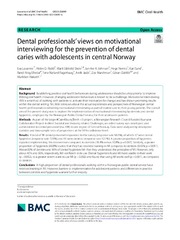Dental professionals’ views on motivational interviewing for the prevention of dental caries with adolescents in central Norway
Permanent lenke
https://hdl.handle.net/10037/32275Dato
2023-11-20Type
Journal articleTidsskriftartikkel
Peer reviewed
Forfatter
Lassemo, Eva Irene Samant; Rodd, Helen D.; Skeie, Marit Slåttelid; Johnsen, Jan Are Kolset; Nermo, Hege; Sand, Kari; Eftedal, Randi Krog; Fagerhaug, Tone Natland; Jasbi, Arefe; Marshman, Zoe; Dahllöf, Göran; Høiseth, MarikkenSammendrag
Methods - As part of the larger #Care4YoungTeeth <3 project, a Norwegian Research Council funded four-year Collaborative Project to Meet Societal and Industry-related Challenges, an online survey was developed and administered to dental personnel (n = 168) in one region of Central Norway. Data were analysed by descriptive statistics and two-sample tests of proportions at the 95% confidence level.
Results - A total of 98 dental personnel responded to the survey (response rate 58.3%), of which 37 were dental hygienists (response rate 72.5%) and 61 were dentists (response rate 52.1%). A greater proportion of hygienists reported implementing this intervention compared to dentists (78.4% versus 50.8%; p = 0.007). Similarly, a greater proportion of hygienists (83.8%) stated that they had received training in MI compared to dentists (65.6%; p = 0.051). About 80% of dentists and 90% of dental hygienists felt that they understood the principles of MI. However, only about 45% and 60%, respectively, felt confident in its use. Dental hygienists found MI more usable in their work (p = 0.052), to a greater extent want to use MI (p = 0.002) and found that using MI works well (p < 0.001), as compared to dentists.
Conclusions - A high proportion of dental professionals working within a Norwegian public dental service have received training in MI. However, barriers to implementation for adolescent patients and differences in practice between dentists and hygienists warrant further enquiry.


 English
English norsk
norsk
